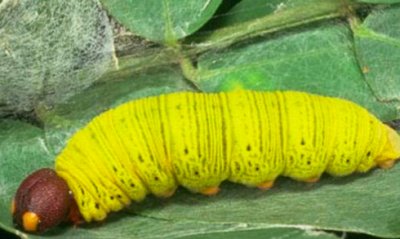The silver-spotted skipper, Epargyreus clarus has a large white spot on the underside of each hind wing, and is one of the largest, most widespread and most recognized skippers in our area. Adults have a jerky style of flight which is typical of many skippers.

Silver spotted skipper feeding on lantana in Eastern CT. Photo by L. Keller.
The silver-spotted skipper is found throughout most of the United States and southern Canada. In the West, it is more restricted to the mountains.
They frequent edges of forests, swamps, brushy areas, and other open areas where nectar plants are found.
The adult butterfly’s wing spread is 1.75 to 2.40 inches. The upper-side of the wings is brown with a row of yellow-gold spots on the forewing. The fringe of the wing is edged with white. The under-side of the wings is brown with a large white patch on each wing.
The caterpillars can be up to 2.0 inches long. They have a reddish brown head with large yellow eye patches and a brown prothoracic shield. Their abdomen is yellow with darker crosswise stripes and orange prolegs. Like most skippers, silver-spotted skipper caterpillars live in leaf shelters. Young caterpillars live in a folded leaf shelter whereas older ones live in a nest of silked-together leaves.

Silver-spotted skipper caterpillar on false indigo. Photograph by J.F. Butler, University of Florida.
The larvae feed on leaves of herbs, vines, shrubs, and trees in the pea family (Fabaceae) including false indigo, black locust, honey locust, American hogpeanut, butterfly pea, American wisteria, Chinese wisteria and other legumes.
Adults have long “tongues” and feed on nectar from a variety of flowers. The silver-spotted skipper favors blue, red, pink, purple, and sometimes white and cream-colored flowers. These include lantana, everlasting pea, common milkweed, red clover, buttonbush, blazing star, and thistles.
Article by Lynn Keller, VMD